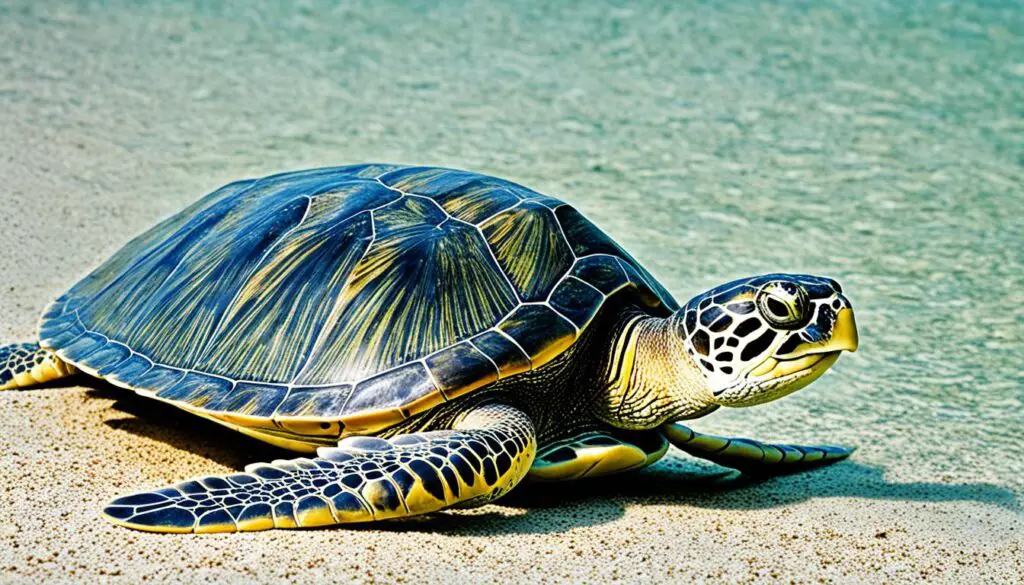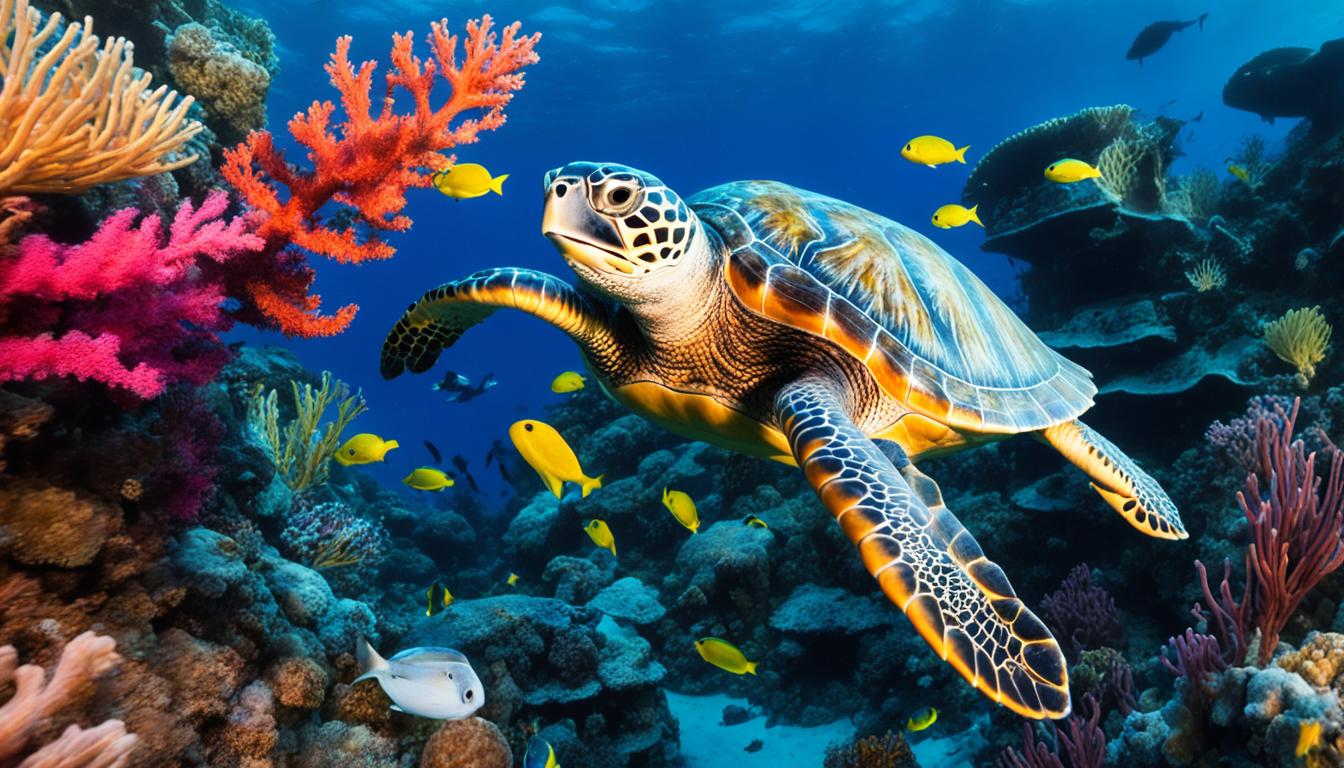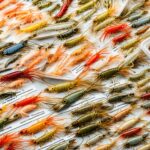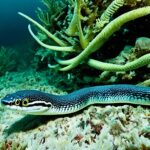Have you ever thought about what sea turtles are? These amazing marine reptiles have been in the oceans for over 110 million years. They have adapted to a life that many of us can only see from a distance. Sea turtles are not just interesting because of their long history. They also play a key role in marine ecosystems.
Learning about sea turtles reveals their amazing biology and the challenges they face today.
The journey from hatchling to adult sea turtle is very dangerous. Only about 1 in 1,000 hatchlings make it through. As you learn more about sea turtles, you’ll see their behaviors, unique habits, and the need for conservation efforts to protect them.
Introduction to Sea Turtles
Sea turtles are a key part of marine life. They play many important roles, like eating and being eaten by other sea creatures. Their eating habits help keep seagrass beds and coral reefs healthy. Sea turtles also have a special place in the culture of many countries around the world.
But, sea turtles are in trouble. Humans harm them with fishing, pollution, and destroying their homes. We need to understand how vital sea turtles are to save them. We must work together to protect these amazing animals and the ecosystems they live in.
What Are Sea Turtles?
Sea turtles live in oceans all over the world. They are big reptiles that breathe air and have hard shells. Their shells have two main parts: the top and the bottom. They are classified as sea turtles in the Order Testudines, in two main families: Cheloniidae and Dermochelyidae.
Looking at their sea turtle anatomy, we see many features that help them in the ocean. Their bodies are shaped for swimming well, and their big flippers help them move through the water. These features are key for their survival, letting them travel long distances to find food and places to nest.
The sea turtle life cycle is an amazing story. It starts with baby turtles coming out of their nests on beaches and then swimming into the open sea. As they grow, they make big journeys, using the Earth’s magnetic fields to find their way. This shows how tough and determined sea turtles are as they face the ocean’s challenges.
We need to understand the problems sea turtles face to help protect them. This means working to save their homes and making sure they can keep living for many years to come.
Types of Sea Turtles
Learning about sea turtles helps us understand their special traits and where they live. Sea turtles are split into two families by their shells and scales.
Overview of Sea Turtle Species
There are seven kinds of sea turtles, each with its own features. The hard-shelled ones are:
- Green Turtle
- Loggerhead Turtle
- Hawksbill Turtle
- Olive Ridley Turtle
- Kemp’s Ridley Turtle
- Flatback Turtle
The leatherback turtle is the only soft-shelled one. Each sea turtle species is crucial to the ocean’s health.
Identifying Features of Sea Turtles
To spot sea turtles, look for their unique traits. Each species has its own set of features, like:
| Sea Turtle Species | Shell Shape | Size (Approx. Length) | Color Pattern |
|---|---|---|---|
| Green Turtle | Heart-shaped | 3 to 4 feet | Olive green |
| Loggerhead Turtle | Large and round | 2.5 to 3.5 feet | Brown with yellow tones |
| Hawksbill Turtle | Compressed and narrow | 2.5 to 3 feet | Dark brown with orange streaks |
| Leatherback Turtle | Oval and leathery | 4 to 8 feet | Dark gray to black |
Each turtle also has a special scale pattern on its face, like human fingerprints.

Sea Turtle Habitat and Behavior
Learning about the sea turtle habitat helps us appreciate these amazing creatures. They live in warm, shallow waters that are key to their survival. You can find them near coral reefs and seagrass beds, where they find plenty of food. These places also protect them from predators, letting them live safely.
Sea turtles show unique behaviors that help them fit in their homes. They make long journeys between places they eat and lay eggs. Female sea turtles always come back to the beach where they were born to nest. This sea turtle nesting happens during certain seasons, with each female laying many eggs in a nest. This shows their amazing ability to navigate, thanks to Earth’s magnetic fields and other signs.
The table below highlights important facts about sea turtle habitats and behaviors:
| Aspect | Description |
|---|---|
| Common Habitats | Warm, shallow ocean waters, coral reefs, seagrass beds |
| Nesting Sites | Natal beaches where females return to lay eggs |
| Migration Patterns | Long-distance travel between feeding and nesting areas |
| Navigational Skills | Use of magnetic fields and environmental cues |
Sea turtles are deeply connected to their sea turtle habitat. This shows how crucial it is to protect these ecosystems for their survival.
Threats to Sea Turtles and Conservation Efforts
Endangered sea turtles face many threats that put their survival at risk. The main threats are fisheries bycatch and ocean pollution. Bycatch happens when turtles get caught in fishing gear. They also eat plastic thinking it’s food, which is harmful to them.
Climate change adds to their problems, affecting where they live and the sex of their babies. Coastal development also harms their homes, making it hard for them to find safe places to lay eggs.
But, there’s hope. Conservation efforts are underway to help sea turtles. These efforts include protecting their nesting sites, enforcing fishing laws, and cleaning the oceans. It’s important to teach people why we need to save these amazing creatures.
By joining local conservation groups or supporting sea turtle protection organizations, you can help. Together, we can make a big difference for these important ocean animals.
FAQ
What are sea turtles?
Sea turtles are ancient marine reptiles that have been around for over 110 million years. They live in tropical and subtropical oceans all over the world. They are well adapted to life in the sea.
How many species of sea turtles are there?
There are seven types of sea turtles. These include the green, loggerhead, hawksbill, olive ridley, Kemp’s ridley, flatback, and the leatherback turtle.
Why are sea turtles important to the marine ecosystem?
Sea turtles are key to keeping marine ecosystems balanced. They eat seagrass and prey on various species. This helps protect coral reefs and keeps the ocean diverse.
What are the threats faced by sea turtles?
Sea turtles face many dangers, like getting caught in fishing gear, pollution, climate change, and losing their homes. These threats put their populations at risk.
What is sea turtle nesting behavior?
Sea turtles have a special nesting behavior. Female turtles go back to where they were born to lay eggs. This is called natal homing.
How do sea turtles navigate during their migrations?
Sea turtles use Earth’s magnetic fields and other environmental signs to find their way. This helps them migrate long distances back to their nesting sites.
What can you do to help with sea turtle conservation?
You can help by supporting groups that protect nesting sites. Reduce plastic use and push for cleaner oceans and better fishing. This all helps sea turtles.
What are the major conservation efforts underway for sea turtles?
Conservation efforts include protecting their nesting places, making fishing rules, and raising awareness. They also focus on fixing damaged habitats that sea turtles need to survive.







